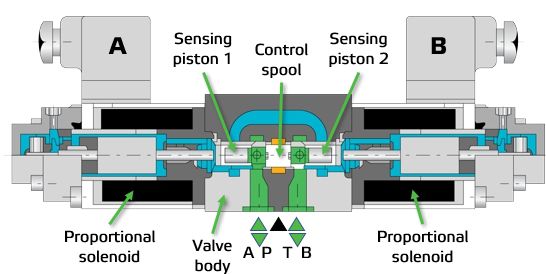Common hydraulic valves - the proportional pressure valve
Jan 26, 2021
Proportional valves are commonly used to control pressure to a cylinder or hydraulic motor. They provide infinite spool positioning and thus infinitely adjustable flow volumes. The resulting flow or pressure output is proportional to the input change, i.e. triple the input produces triple the output.
They are controlled electronically either by sending a voltage (10V to 10V) or current signal (420mA) to the valve depending on model of valve. The electrical signal supplied to the solenoid coils creates a variable force that overcomes a spring force and shifts the main spool enough to allow supply pressure (P) to flow to port A or B.

Example proportional valve
For example, if solenoid B receives a signal, it shifts the main spool to the left, allowing oil to flow to and increase pressure in port A. Radial drillings in the main spool allow some oil to go to the left side of piston sensor 1. Oil in this area and in port A combine to work against the force of solenoid B until equilibrium is reached. If port A increases more than solenoid B’s force, the main spool will shift to the right and allow some of port A’s oil go to the tank.
For more information on maintaining your hydraulic system, contact your Valmet representative.